

Overview:
After printing the squirrel model, designer sand it smooth and apply color to it.
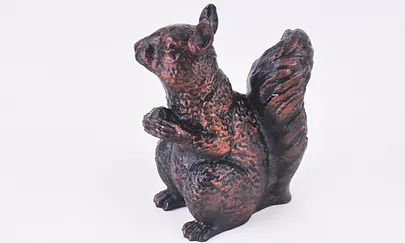
Project Introduction
When crafting with FDM 3D printer, designers sometimes feel that they are bound by the materials. Currently, FDM 3D printer mainly uses thermoplastic as the raw materials, as well as the surface texture. However, with post process, the printed model can be more colorful and even has a metal texture.
Print the model
For this project, we use a squirrel model as an example. After sliced by 3DStar software, the model was saved in a USB drive and loaded into the Einstart-C 3D printer. Couple hours later, a beautiful squirrel was printed and ready for post process.
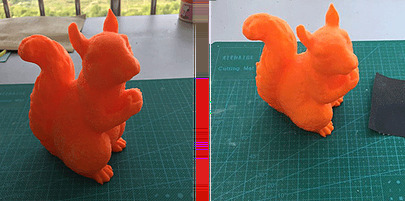
Polish the Surface
Surface polish is necessary for later coloring. Using a fine sand paper to smooth the surface.
Coloring
Acrylic paint was used for coloring in this model as it has a strong bond with the PLA model surface. To paint the model, the first step is to apply a black base. Use black acrylic paint to cover the whole model evenly.
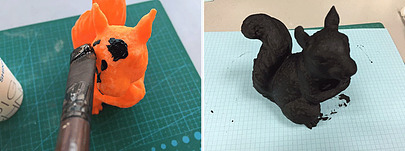
Wait for the base paint to dry and then apply bronze paint. Dry up the bronze paint a little bit before painting onto the model. This will prevent the paint from flowing into detailed place and destroying the texture. Gently brush the surface so that the paint only apply to the protruding area.
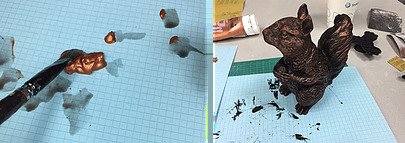
Finally, apply varnish paint to make the surface shining and create a metal reflective effect. Also, varnish can protect other paint layers.

With post process, it is possible to use a low-cost desktop 3D printer to create wonderful art with different textures.
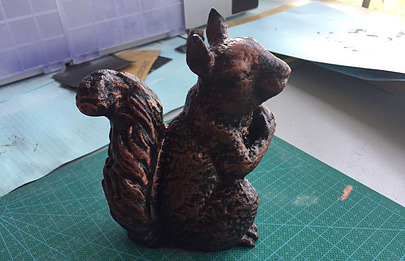
Background:
Recently, School of Engineering, Zhejiang University of Technology (ZJUT) invited SHINING 3D to join the first “Alumni Mentor Program” to be one of the 13 distinguished alumni mentoring 42 students majoring in mechanics. The first project SHINING 3D instructed students from the ZJUT racing team was to customize their racecars with 3D digitalization and 3D printing technologies.Background:Recently, School of Engineering, Zhejiang University of Technology (ZJUT) invited SHINING 3D to join the first “Alumni Mentor Program” to be one of the 13 distinguished alumni mentoring 42 students majoring in mechanics. The first project SHINING 3D instructed students from the ZJUT racing team was to customize their racecars with 3D digitalization and 3D printing technologies.
Lesson 1: Customize the steering wheel handles for the racers
Racing as an intense competition requires a high level of driving skills. Thus the steering wheel handle needs to perfectly fit the racer’s hands, otherwise, the racing performance may be affected. SHINING 3D guided and instructed the students to customize personalized steering wheel handles with 3D scanning and 3D printing technologies.
1. Use the plasticine to get the racer’s handprints
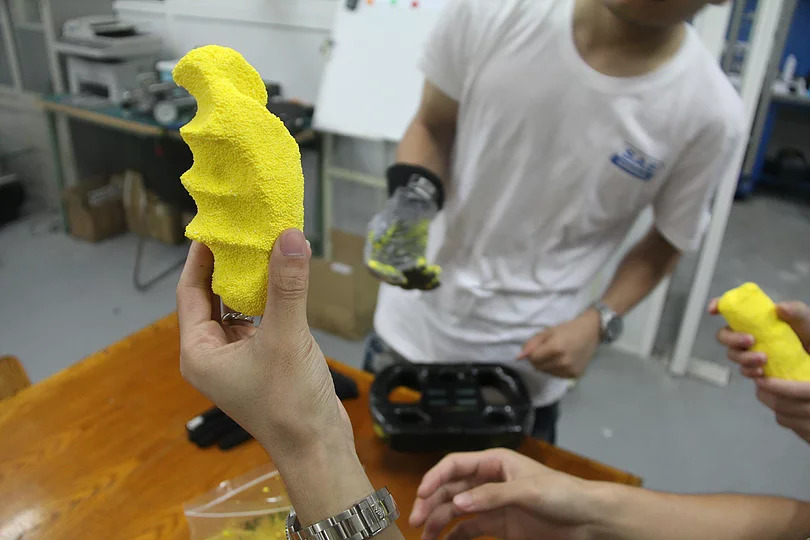
2. Use EinScan-SE for 3D scanning of the handprints
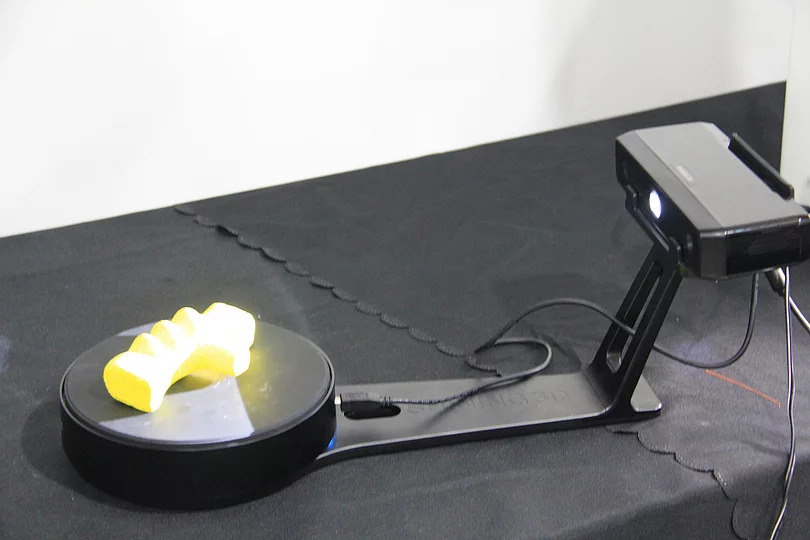
3. Design the steering wheel handle based on the 3D data

4. Print out the handle using 3D printers and install it on the steering wheel.
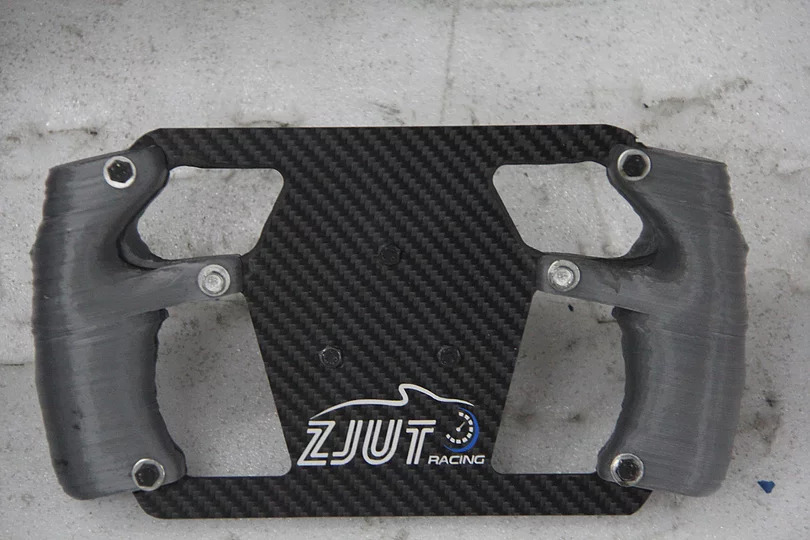
The 3D printed handle perfectly fit the outline of the racer’s hands, allowing the racer to operate it easily and conveniently during the intense competition, without any concerns about the pain caused by overexertion and poor fitting between the handle and hands.
Lesson 2: Rapid making the front part of racecars
In addition to steering wheel handles, the racing team, under the guidance of their mentors, also tried to make the front part of the racecar using 3D printing technologies.
1. 3D Printing
Use the industrial 3D printer to print out the front part of the racecar.
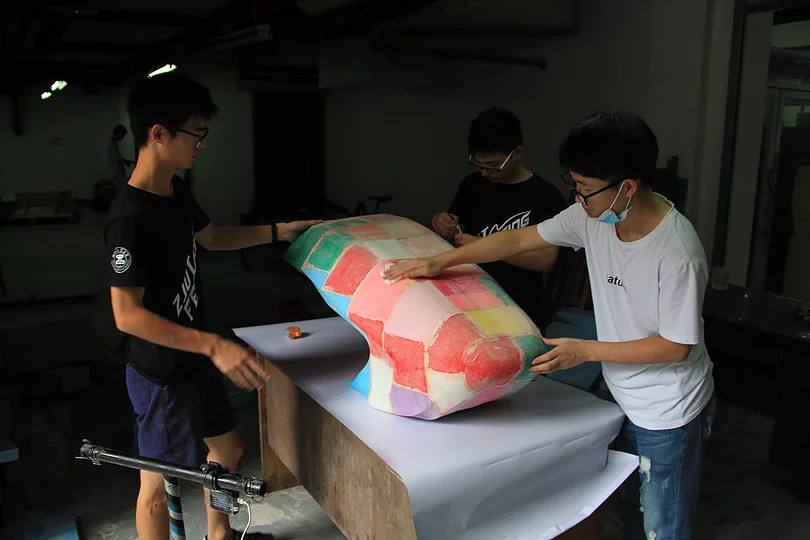
2. Hardening & surface finishing
After the preliminary molding, the team members conducted the surface finishing for the front part of the racecar and placed it horizontally for hardening. After the hardening, the mold became strong enough to complete the evacuation and then do the manual finishing on the surface again.
3. Covering with carbon fiber fabrics
The surface of the mold was applied with the wax and covered with multiple layers of carbon fiber fabrics tailored based on the outline of the mold. A layer of epoxy resin was painted on each layer of the carbon fiber fabric.
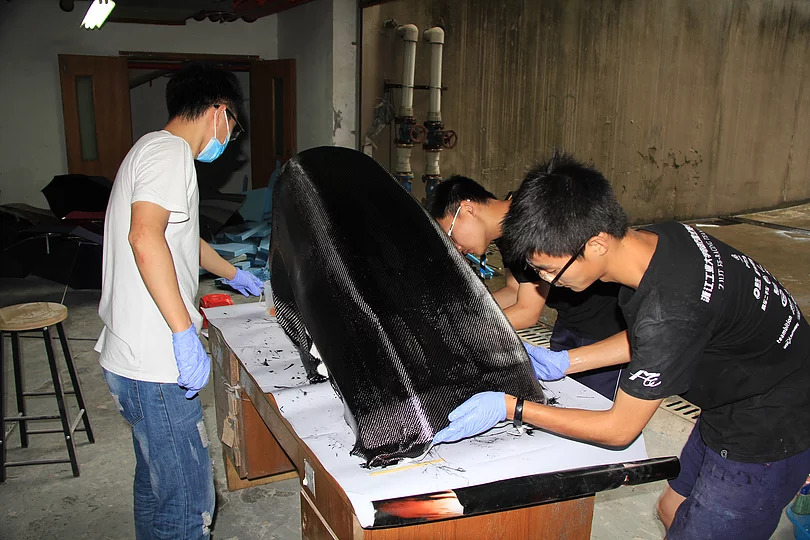
4. Evacuation & curing
The racing car head was put into a vacuum bag, which was connected to an air pump. After the evacuation, the vacuum bag was sealed and placed for more than 24 hours to ensure the complete curing of the resin.

5. Demoulding
When the 3D printed mold was removed after opening the vacuum bag, the front part of the racecar with the carbon fiber cover was complete.

Summary:
3D digitization and 3D printing technologies helped the ZJUT racing team to complete the design and manufacture of certain parts of the racecar without any existing mold, which saved both the time and cost. In addition, it also encouraged the student to create more innovations without any restrictions on the processing technology.
Overview:
After 3D scanning the clay model using EinScan-SE desktop 3D scanner, students edited the model with Autodesk 123D and printed with Einstart-C desktop 3D printer.

Project Introduction
In STEAM education, the major challenge for the teacher is to grab the students’ attention and create their interest. For example, in an art class, it will be monotonous if the students only design the sculptures on the paper without creating the physical objects that could be brought home to memorizing their hard work. With the help of 3D scanning and 3D printing technology, students now can model the sculptures, 3D scan them to get the digital models and then transform them into other useful objects such as a pen holder. In this way, students will be able to explore and test their skills in varieties of aspects including creativity, technical skill, and aesthetic ability.
Make the Sculpture
Students can use clay to make any characters they like. It could be animals, cartoon characters or other objects that they are familiar with. For instance, one of the students made a clay cartoon character in the picture below.
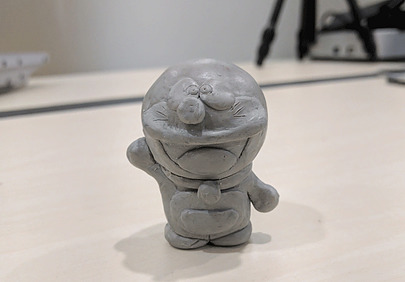
Scan the Sculpture
After the clay model was made, the next step was to digitalize it. Students can use the 3D desktop scanner EinScan-SE to get the 3D model data, which can be further edited in the 3D software including smoothing the surface and adding more features that are hard to make by hands.

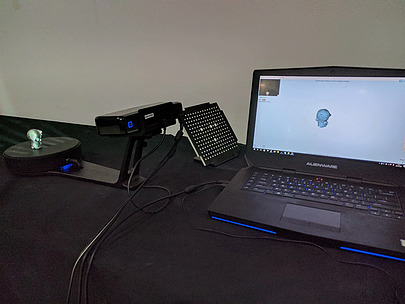
Modify the Model
The 3D model was then loaded into 3D design software for modification. In this case, the talented student used 123D Design from Autodesk to transform the cartoon character into a pen holder by adding a base and carving a hole from the top.
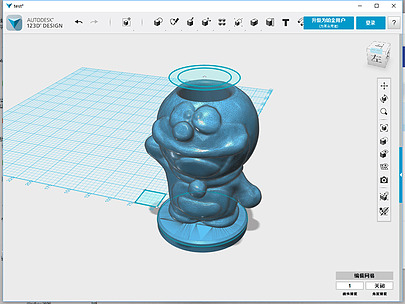
Print the Object
Finally, the 3D model after designing was sliced and 3D printed by the desktop 3D printer Einstart-C. The 3D printing process was quite easy: just export the .stl model file from 3Dstar software to the printer by a USB drive and press the start button. The printing speed of Einstart-C is faster than many other 3D printers. It only took about 7 hours to print the 123mm high model.
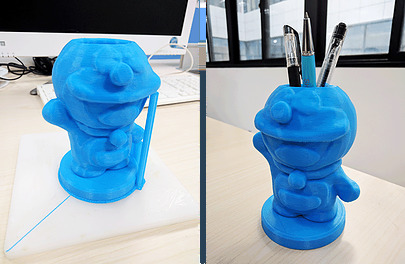
With the printer, students can take a meaningful reward home quickly and easily. With the printer, the STEAM class can offer both depths of the knowledge and endless joy of design.
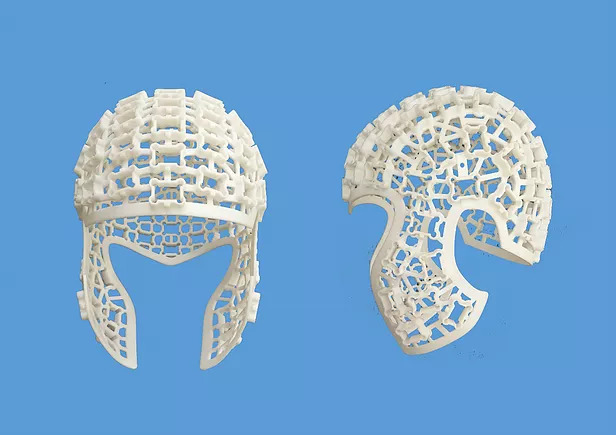
Client Introduction
Prod-lab, the first “Manufacturing laboratory” in China that providing manufacturing service, focus on the product demonstration and specializes in small-batch and personalized manufacturing. It triggers the manufacturing democracy in the Internet era, releases people’s passion for creation and becomes a pioneer in providing member service and training of individual manufacturing in China through community, application and space.
Background
When a person’s brain is active, brainwaves are produced by synchronized electrical pulses from masses of neurons communicating with each other. Study on brainwaves has always been a frontier in science circle. Thus, it’s necessary for the research to capture the brainwaves and convert them into signals quickly and accurately.
Overview
Commissioned by an academy of sciences, Prod-lab created a tailor-made helmet that fully fitted with a person’s head by scanning the human head by EinScan-Pro, for research in brainwaves.
Process
1. Head Scanning
The engineer at Prod-lab used handheld 3D scanner EinScan-Pro to scan the human’s head. As the engineer moved the scanner, the 3D data of the head was displayed in real-time. With the quick and easy operation, a complete scanning of head data was finished in a short time.
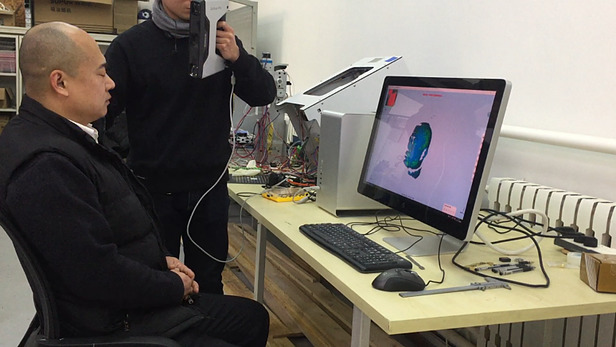
2. Reverse Engineering
After obtaining the 3D data of the human’s head, the engineer at Prod-lab used Fusion 360 software to extract the point cloud data of use. Based on the scanned point cloud data model, they designed a testing helmet that tightly fitted the head and facilitated precise positioning of the sensor.

3. Helmet Design
Engineers constructed a full-scale head model according to the collected point cloud data.
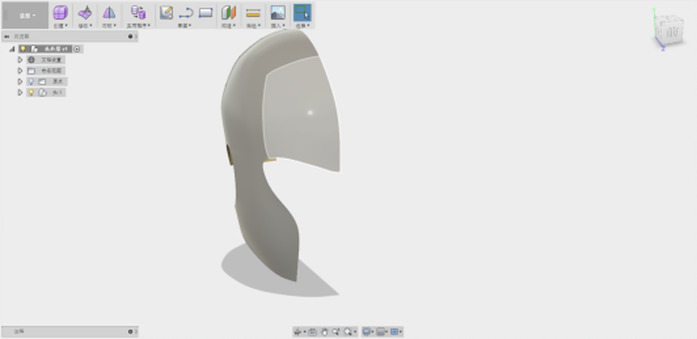
Then they determined space positioning of the helmet jack by the confirmed head model.
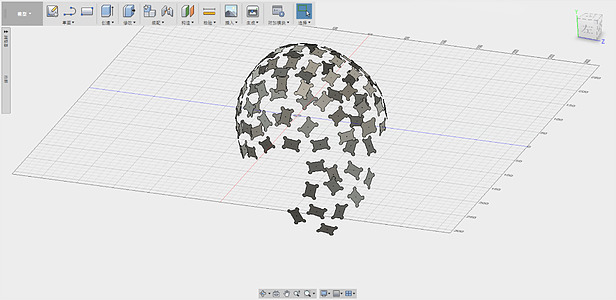
Completed the helmet design based on the 3D data obtained in the previous step.
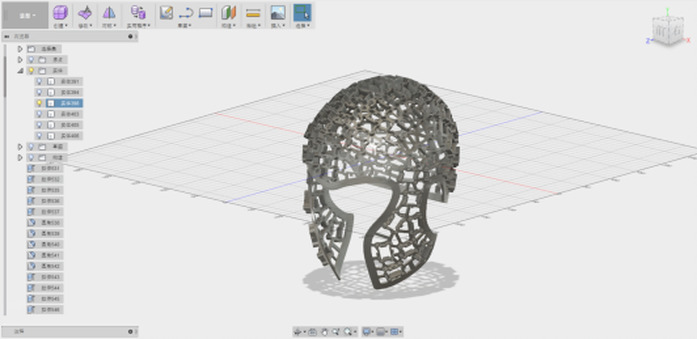
4. 3D Printing
After 24 hours of processing, the brainwaves’ helmet was 3D printed by using toughened photosensitive resin, using SLA 3D printer produce the brainwave helmet with high strength resin.

5. Helmet Fitting
The client tried on the helmet which was perfectly fitting with the head. The client believed that with the helmet support for the test, their research progress had definitely reached a world’s leading level.
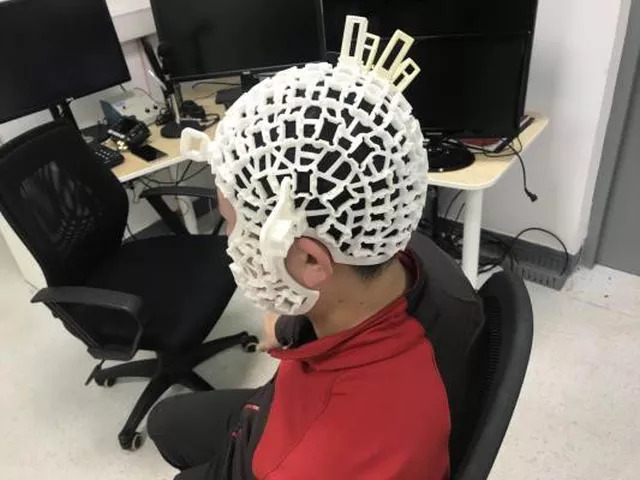
Bringing the fast scanning speed and high-accuracy 3D data, SHINING 3D’s 3D scanners are applicable to a wide range of research and projects. In addition, the future relationship between brainwave research and 3D digitizing and 3D printing will be even closer, we are looking forward to creating more innovation.
THE CHALLENGE
Ancient cities like Babylon, have been subject to years of plunder, neglect and ongoing conflicts reducing them to faint facsimiles of their illustrious past. Babylon has repeatedly been denied World Heritage Site Designation because the city lacks; clearly-defined boundaries, a comprehensive preservation plan and safeguards to ensure sustainable tourism. The future of Babylon is now an essential topic for heritage conservation.
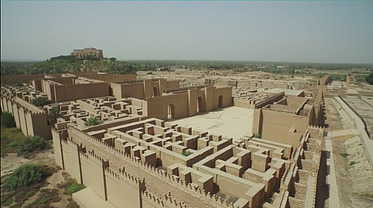
Although the original splendor of places such as the wondrous “Hanging Garden” are long gone, new preservations attempts are being undertaken by the local Iraqi government and the WMF (World Monument Fund). Per the WMF, many challenges persist such as; repairing the damage caused by military conflict and assessing the effects of twentieth-century construction on ancient artifacts. Furthermore, the WMF is tasked with helping Iraqi authorities prepare the site for visitors to enjoy the “Cradle of Civilization”.
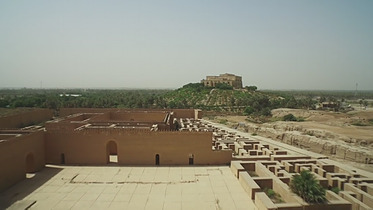
SHINING 3D focuses on the fusion and innovation between 3D scanning and printing. The company’s cohesive solutions have been successfully applied to cultural relic archival, sculpture, scientific research and vocational education. Throughout the company’s history, there has an emphasis on helping customers realize the value of additive manufacturing and its application to the restoration and archival of ancient artifacts.
THE SOLUTION
As part of the popular video series “The Trueman Show”, Xinyu Zhang and Hong Liang, an adventurous travel couple traveled to the ancient city of Babylon. Their mission was to donate a Shining 3D EinScan Handheld 3D Scanner and an EinStart-S 3D printer to the Iraq government. The goal of the Shining 3D donation was to support local Iraqi preservation of cultural relics.
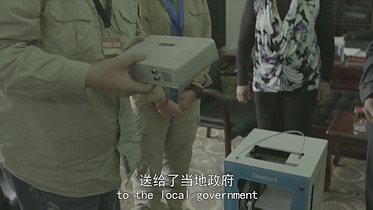
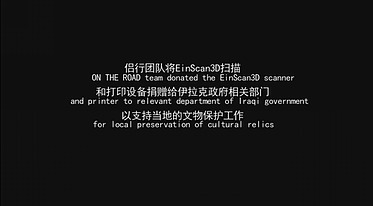
Shining 3D has made significant breakthroughs in 3D archaeological perseveration technology and believes strongly in the establishment of an International Standard for cultural relic and archaeological site digitalization and archival. Shining 3D newly developed scanning and printing technology will have broad research and application impact in this important field.
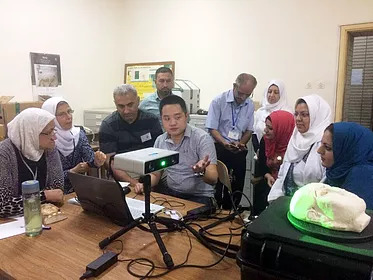
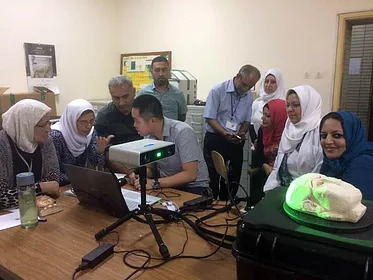
During their visit to the Babylon government office, Shining 3D technicians delivered comprehensive training on the various applications of 3D scanning and 3D printing. They introduced valuable 3D scanning and printing concepts to local government officers to educate them in the capture and archival of ancient cultural relics. The EinScan-Pro’s four operating modes make it the perfect choice because the multi-functional 3D scanner offers both portability and high-accuracy capture abilities.
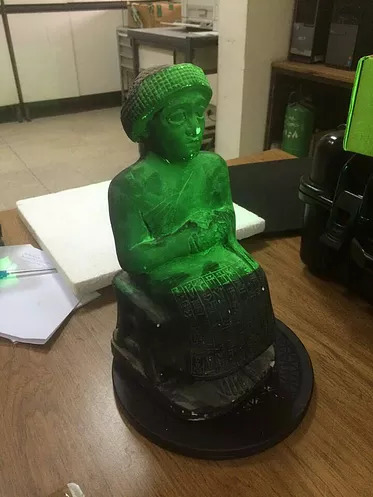
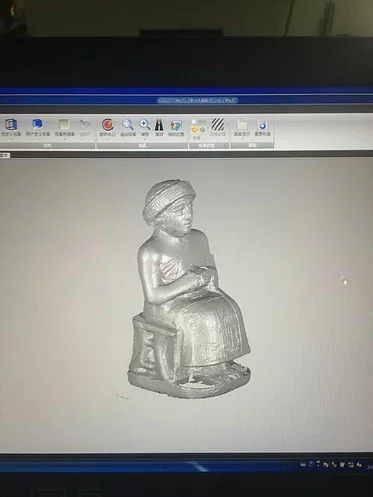
The example shown here illustrates how the EinScan 3D scanner acquired the surface data of a porcelain doll for archival as an 3D model in a computer. A CAD technician can then use the 3D model to recreate missing parts or to add a 3D printing support structure. The EinStart-S’ innovative print technology will allow the Iraqi government to print delicate objects with smooth, accurate surfaces with easily removable 3D printer support.
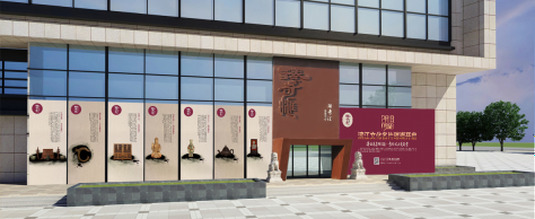
For the majority of people cultural relics are beyond reach, not only in terms of ownership but also simply to visit and experience first hand. The unfortunate reality is that the majority of such ancient works are stored in archives, closed private collections or on public display in far away places, meaning the rich potential benefits gained from seeing and experiencing these in person are limited to a select few.
SHINING 3D are applying their latest 3D technology to help a gallery owner in the Binjiang District of Hangzhou give easy and open access to his family collection and share these artifacts as widely as possible.
The Zhenqihui Art Center, located in Hangzhou (www.zqhart.com) hosts a highly impressive collection that has been gathered by Wang Xin and his family over the past 30 years. Driven by a passion for collection that dates back through three generations of the Xin family and a desire to share this wealth of Chinese history with as many people as possible, the Zhenqihui Art Center boasts nine themed exhibition rooms, all open to the public. The center is home to a wide range of precious works including jade and stone, dragon imagery, ancient furniture, pottery and porcelain, Buddhist statues, teapots, paintings and calligraphy. The works span an incredible five thousand years of Chinese history, from the Neolithic period through the Shang and Zhou Dynasties, the Jin and Southern Dynasties, the Tang Dynasty, the Five Dynasties and the Song, Yuan, Ming and Qing Dynasty (around 300 years ago).
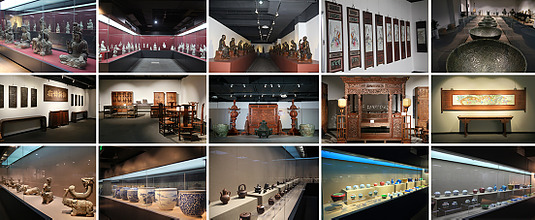
Despite having such a large collection of incredible artifacts, Wang still has his favorites, chiefly a particularly impressive series of fourteen statues from the Tang Dynasty (dating back 1300 years). Six of these statues depict Chinese maids from the period and eight further statues are collectively named as the ‘Ba Yin Ladies’. “Ba Yin” refers to the ancient Chinese musical instruments: zhong, qing, qin, xiao, sheng, xun, gu and zhu.
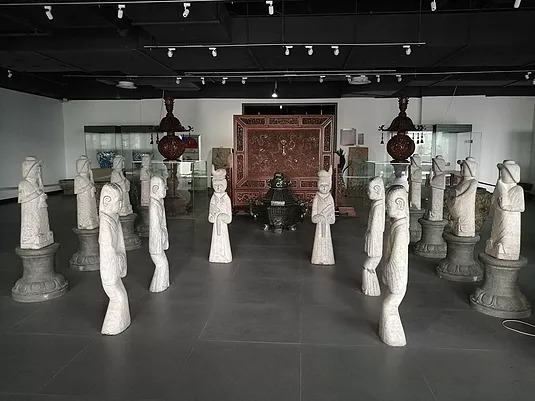
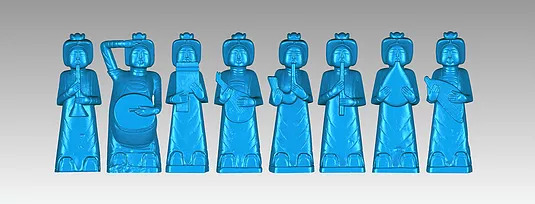
The 14 statues of the Tang Dynasty are extremely precious and fragile therefore not suitable to be transported long distances to be exhibited remotely for extended periods of time. However, the owner’s passion to share these works has led him to appoint SHINING 3D to capture their form in high precision digital detail, to be freely shared for remote viewing and also potentially be used to make physical replicas using 3D printing technologies.
Given that the more traditional methods of 3D surface replication can require physical contact or even creating molds from the original pieces, these are not suitable for precious cultural relics which may be easily damaged by such processes. The owner, also being passionate about new technological innovations, contacted SHINING 3D to enquire what capabilities they had to available capture the form and fine detail for sharing, reproduction and also digital archiving in case of future need for restoration, without damaging the statues.

Fast handheld scanning: 1.2m statues captured in 10 minutes
The team at SHINING 3D were very pleased to receive the enquiry and support Wang in his passion to share his collection. SHINING 3D produce several different levels of 3D scanner ranging from the highly cost effective EinScan-S, designed for quick and easy capture for personal or mass-market use, through to the OptimScan, which is targeted to industrial applications. The scanner selected for this job was EinScan-Pro, SHINING 3D’s latest innovation. EinScan-Pro offers four different capture modes each of which provide different capabilities and benefits to the operator. Handheld Rapid Scan, Handheld HD Scan, Automatic Scan and Free Scan (for more details of these different modes see https://www.einscan.com/einscan-pro). The Handheld Rapid Scan function gives the operator the freedom of controlling the scanner by hand to dynamically capture the surface in real time, different to other static capture modes where the 3D scanner is mounted on a fixed tripod for capture. Handheld Rapid Scan mode captures a 210mm x 150mm 3D grid of data with a resolution between 0.5mm and 2mm at 0.3mm accuracy, 10 times every second. EinScan-Pro offers incredible value to the user, providing access to professional grade 3D capture at a very economical price (see https://www.einscan.com/shop and https://www.einscan.com/contact for more details on how to buy).
The Chinese maid statues are 1.2 m tall with a smooth contoured surface and therefore the handheld fast scanning mode of EinScan-Pro was ideal. One additional benefit of this mode is that it does not require any reference target marks to be applied to the surface, or for the surface to be spray powder coated with developing agent, a feature that is clearly very important for scanning fragile or ancient artifacts. The total scan time was very rapid at only 10 minutes for each statue. The raw scan data was then rapidly processed within SHINING 3D’s own software that has automatic tools for creating a watertight mesh, ready 3D printing or remote sharing and visualization.
SHINING 3D employed their latest SLA 3D printing technology to create an initial miniature replica made from photosensitive resin. Both the overall form and also detailed features of the statue are accurately preserved by virtue of the advanced capabilities of SHINING 3D technology, enabling remote 3D printing and viewing by people unable to travel the distance to visit the original works in Hangzhou.
Following the successful scan and reproduction of the first statue, SHINING 3D then continued to follow the same process to capture the remaining statues in this series for the Zhenqihui Art Center.
Wang Xin was very impressed with SHINING 3D and their technologies. “The whole scanning process is amazing, the scanner can capture the 3D image of the originals in such a short time.” Wang went on to add that the application of this technology to his family collection provides so much potential. “It means so much to us to be able to extensively digitize and share these priceless works online for the general public to access.”
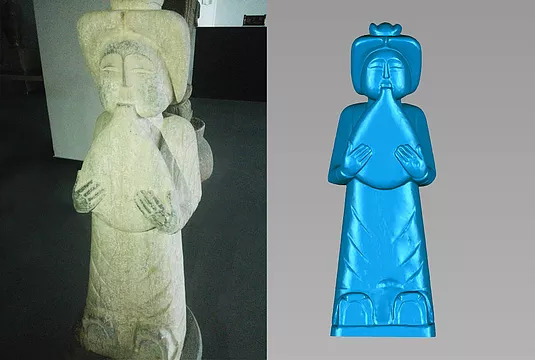
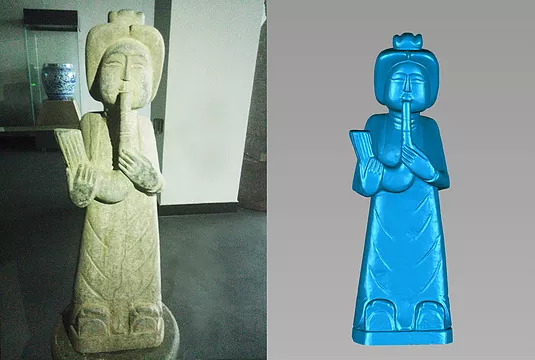

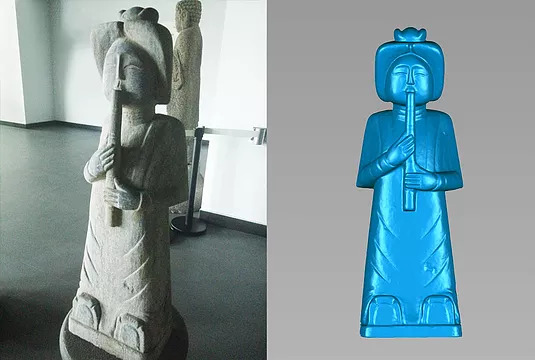
The next step for the Zhenqihui Art Center is to further expand its digital archives. Wang now wants SHINING 3D to scan as many works as possible to make them available as a virtual on-line museum. This ongoing activity not only represents a strengthening of the relationship between the Zhenqihui Art Center and SHINING 3D, but also a deeper connectivity between the most ancient of worlds and the most modern.
SHINING 3D: einscan.com
Zhenqihui Art Center: www.zqhart.com
Free Download: www.myminifactory.com
Overview:
Renowned online 3D printing platform MyMiniFactory used Shining 3D’s EinScan-Pro 3D scanner to scan the sculptures from the Faculty of Classics, University of Cambridge at“Scan the World”, a large-scale public service event. This was to establish a 3D model database of such sculptures. EinScan-Pro 3D scanner aids in establishment of sculpture digital museum.

Background
Renowned online 3D printing platform MyMiniFactory has established a large-scale public-service event called Scan the World. The purpose of the event is to share art in the form of 3D data with the whole world so that precious artworks from all corners of the world can be accessed by people in the form of downloading and 3D printing. MyMiniFactory ‘s technicians have used Shining3D’s EinScan-Pro 3D scanner to render 3D images of sculptures collected by the Faculty of Classics, University of Cambridge for storage and sharing.
Customer Profile
MyMiniFactory, which launched in 2013, is the world’s leading curated social platform for 3D printable objects. It has over 20,000 3D printable files, and a community of 200,000 users.
Scanning Process
On site, the technicians first removed the EinScan-Pro from its carrying case and then connected it to the laptop as part of pre-scanning preparation.
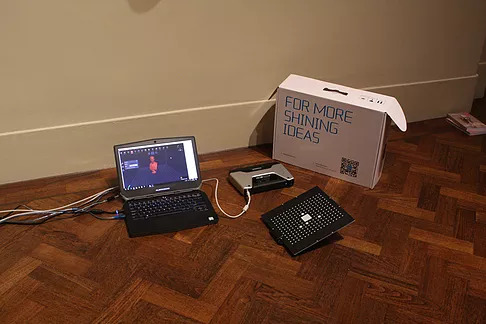
As the scanner may have been affected by vibrations and jolts during transportation, it was first quickly calibrated by technicians to ensure the accuracy of the scan data.

After the calibration, the technicians began to scan the sculptures using the EinScan-Pro’s handheld rapid scanning mode. Using this mode, the technicians could scan large sculptures more quickly while avoiding the damage to sculptures caused by markers.

The scanner can be used in any environment without any special requirements, even in the dim environs of the museum, the sculptures could be scanned directly.
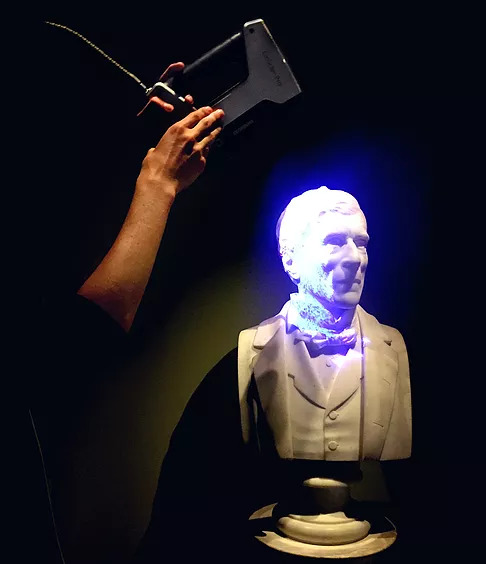
The data obtained by the scanner was shown in real-time on the EinScan-Pro software on the computer. This allowed technicians to monitor the scanning process and the quality of the scanned data.
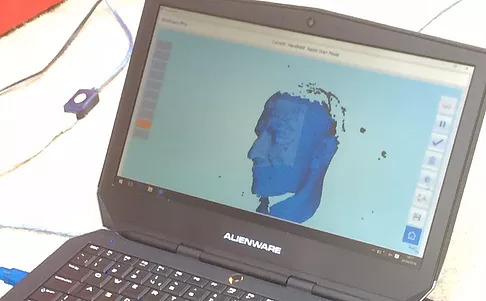
The scanning of a single sculpture was completed in mere ten minutes.
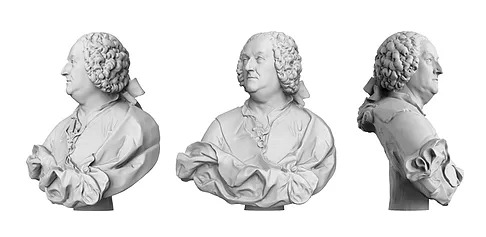
The students of the Faculty of Classics also tried using the EinScan-Pro scanner to scan the sculptures. The students marveled at how simple it was to use the EinScan-Pro, despite the fact that they had not yet been trained in 3D scanning, they could obtain 3D data with easy scanning.

Apart from University of Cambridge, Shining3D’s EinScan-Pro is also being used by MyMiniFactory in its Scan the World event with museums, art institutions, and elite schools all over the world. Up to date, over 4,600 artworks have already been scanned, and the scanned data have already been stored and made available to the public for downloading and exporting for 3D printing.
Overview: Zhang Fei 3D Print art studio, during the restoration of the Henan kiln twistable clay body process in Song Dynasty, scans the artifacts with SHINING 3D’s handheld EinScan-Pro 3D Scanner. On the basis of the high-accuracy data acquired by 3D scanning, the designer adopts the reverse engineering technology to create digital 3D models for the remainder of artifacts and prints them out with a 3D printer, and performs the post-processing to complete the restoration.
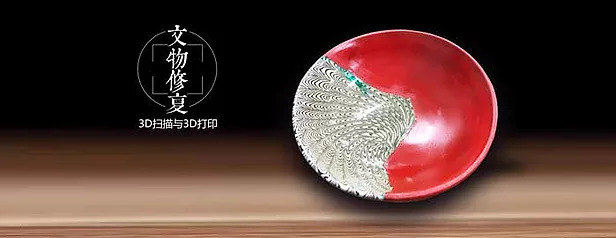
I. 3D Scanning
The designer fixes the EinScan-Pro onto a dedicated tripod and places the porcelain fragments in the center of the EinScan-Pro turntable. Subsequently, the designer adopts a fixed free scanning mode and selects the highest accuracy (scanning accuracy of 0.05 mm) to scan the artifacts.

·Original of Song Dynasty Porcelain with Twistable Clay Body

·Scanning Song Dynasty porcelain fragments with EinScan-Pro
After several times of automatic scanning process, the point cloud data of the porcelain fragments are gradually formed in the software coming with EinScan-Pro. Thanks to the high scanning resolution of EinScan-Pro, the tiny details on the appearance and section of the artifacts are preserved. After the scan is completed, the designer converts the point cloud data into triangular slice data in the software. During the conversion process, the designer selects the “simplified model” value as 100 to preserve the full details of the model. After the conversion is completed, the data are outputted and saved as stl and obj files.
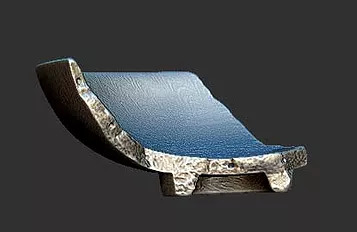
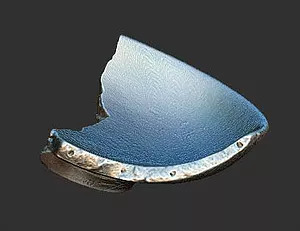
·After the 3D scanning is finished, the 3D data with rich details are obtained
II. Design
The designer will import the obj file obtained from scanning into Zbrunsh. Due to the high number of scanned out model faces, a lot of 3D software cannot cope with this situation, while Zbrush can withstand. Stl files can also be imported into zbrush, but the size often becomes smaller after export, so the designer decides to use zbrush to directly edit obj file.
The twistable body texture brush specially crafted in the software enables the well trimming of the seams between the artifacts and the restoration part. Finally, the Boolean operation is made to get the complete model of the final restoration part.
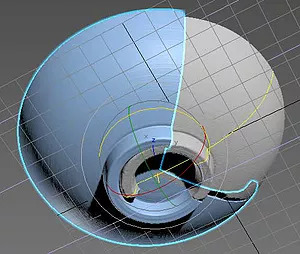
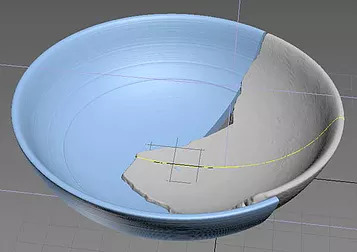
·The designer restores the remainder of the artifacts in the 3D modeling software Zbrush
III. Printing and Post-processing
The designer exports the repaired model and transmit it into the printer slice software for printing operations. The 3D printer, after working for more than 10 hours, prints out the restoration part of the artifacts.
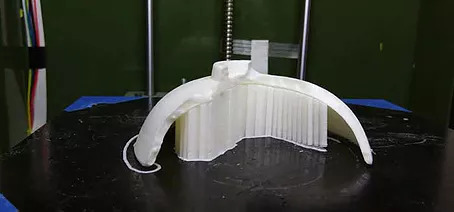
·Artifacts Restoration Part during Printing
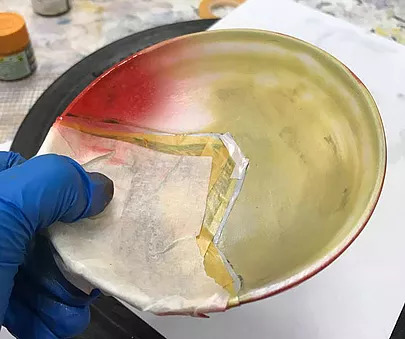
·Post-processing the printed out restored part
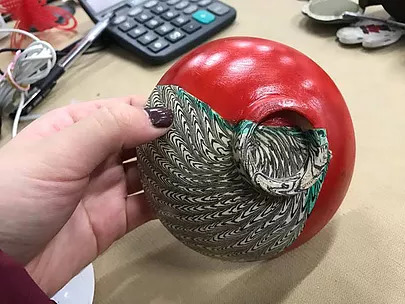
·Restored Song Dynasty Porcelain Artifacts
– Customer Profile –
Zhang Fei 3D Print art studio is a studio spontaneously created by the teachers and students in the College of Art & Design of Beijing University of Technology. On the way of art exploration, the teachers and students apply the most cutting-edge 3D printing means, judiciously combine the science & technology with the art, and keep trying a variety of possible creations. Over the past year, they started from their design and animation specialties, and gradually stepped into the relevant art and design industry, and made a lot of attempts to give a full play to the convenience of the new technology. The new technical means can set the designers free from the learning of the complex processing technology, so as to make the cross-border design come true.
THE CHALLENGE
Our story begins with an 800-student Hangzhou, Xingzhi High school, honoring the merits of the educator Tao Xingzhi (1891-1946). The great Chinese patriot Tao Xingzhi was an educator, ideologist and a leader of the National Salvation Association and the China Democratic League. In terms of education, his theory of “life and education theory-popularizing mass education” set an example for modern Chinese education. Xingzhi High School has always followed his education thoughts since its foundation and therefore attaches great importance to the reconstruction of his namesake memorial hall.
Recently, Xingzhi High School began a comprehensive restoration of their Memorial Hall. Unfortunately, prior to the restoration efforts began, the original Tao Xingzhi Statue suffered damage as a result of an accident. Since the statue has special significance for the school, it became a shared challenge for both staff and students to work together in “The quest to restore Xingzhi High School’s symbolic statue”.

THE SOLUTION
The quest to restore Xingzhi High School’s symbolic statue
One of the faculty goals for the restoration was to combine it with lectures about 3D that would enhance students’ exploration into the exciting world of 3D scanning and 3D printing. The school’s 3D Creativity Association cooperated with the SHINING 3D team to ensure that students gained valuable experience and knowhow through their hands-on scanning efforts.
The School already owned a number of EinStart-S desktop 3D printers which would be used by the 3D Creativity Association for restoring the statue with 3D scanning technology. Under pressure to finish the restoration prior to the reopening of the Hall, they contacted SHINING 3D for help. SHINING 3D decided to use the EinScan-Pro multi-functional handheld 3D scanner to acquire the statue surface data for digital modeling and archival
The original Tao Xingzhi Statue was 90 cm long by 40 cm wide by 80 cm high and had been severely weather damaged which made the restoration efforts even more difficult. The 3D Creativity Association planned to use the latest 3D digital technology to scan and print the statue in a 1:1 scale.
By operating the EinScan-Pro by themselves, the students learned valuable lessons. The gained insight into how to capture real world objects and how to save them for use in the 3D digital realm. Prior to the restoration project, many students thought that the only way to create 3D models was by using CAD (Computer-Aided Design) modeling software. All the models created by 3D scanning would be sent directly to a 3D printer. So, the quest to recreate their beloved statue, would also teach about 3D printing.
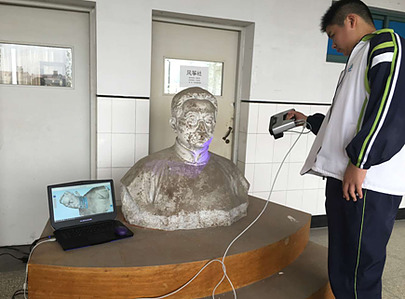
Initially, the student seemed shy about using advanced 3D scanning technology but because the fast scanning mode of the EinScan-Pro is simple to use, they became increasingly enthusiastic after about 10 minutes. Furthermore, EinScan-Pro technology doesn’t require any marker point placement or pre-spraying of a development agent. This makes the EinScan-Pro suitable for scanning large parts, human bodies and statues. In this particular case, the entire scanning process only took 5 minutes using a scanning speed of 10 fps.
Results and benefits
The EinScan-Pro supports fully-automatic mosaic creation which can be output as individual, print-ready 3D data files. After successful model acquisition, the EinScan-Pro calculated and stored a digital 3D model for restorative modeling of the damaged statue parts.
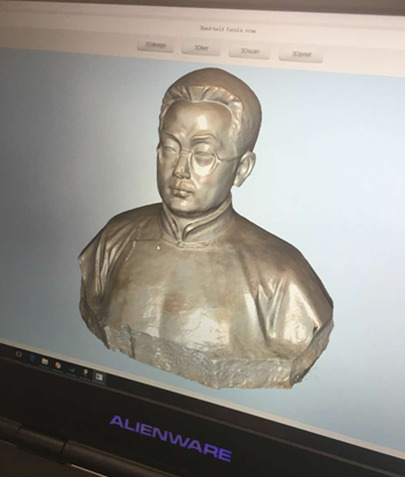
Due to the statue’s large size, the team decided to use FFF 3D printing technology. Fused Filament Fabrication is a 3D printing process that forces a continuous filament of a molten material out of the print nozzle to be deposited on the growing statue part. The Shining 3D EinStart-L used PLA material to print each mosaic-part which was then carefully assembled to create the full-scale replica.
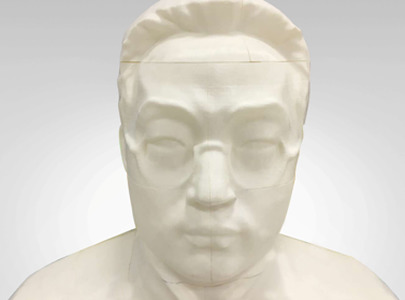
After splicing, polishing and coloring, the 3D-printed Tao Xingzhi Statue was finally complete. The staff and students were overjoyed at the sight of the brand new statue that had been replicated entirely using Shining 3D scan and print technology.
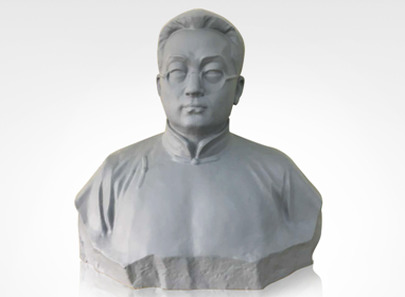
The entire school held a ceremony to honor the restored Tao Xingzhi Statue in its new home in the Memorial Hall.
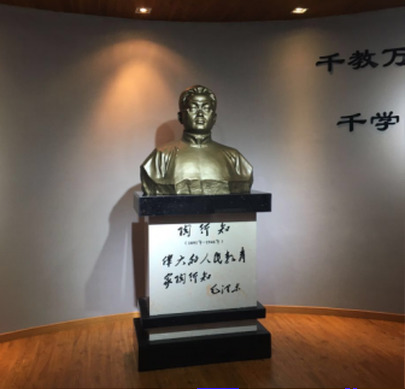
“The statue serves to remind both faculty and students to pay tribute to Tao Xingzhi and practice his teachings, “Acting is the beginning of knowledge while knowledge is the outcome of acting”
Xingzhi High school
Industry: Artifact Restoration
Previous Solution: None
Benefit: Education, Historic Value, Honoring the merits of an Educator
A team led by Professor Nan Yu from Sculpture major at Guangzhou Academy of Fine arts applied 3D scanning and 3D printing technologies to their artwork creation. They reproduced the scene of appointing Tso Tsung-Tang (You may know the famous food of General Tso’s Chicken, which has the same name, but in fact they have no relation at all), one of the four prominent ministers in the late Qing Dynasty, to be the principal of Lujiang Academy, paying their tribute to the Chinese tradition of ancient academy culture and virtual of respecting teachers.
Principal Appointment miniature scene, Nan Yu
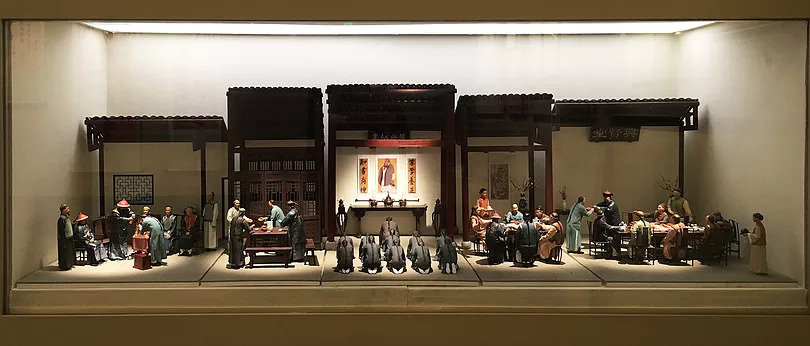
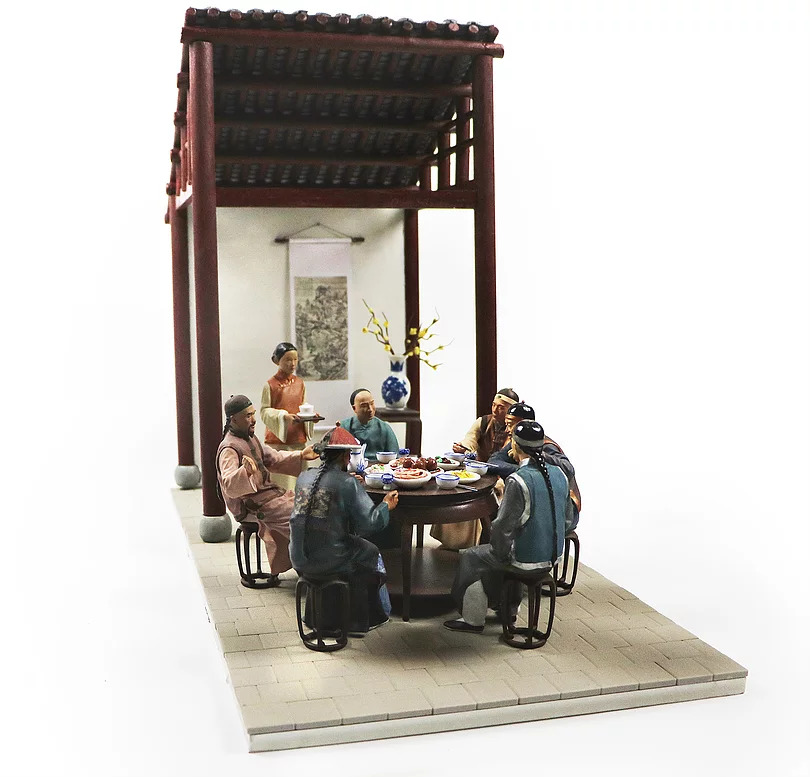
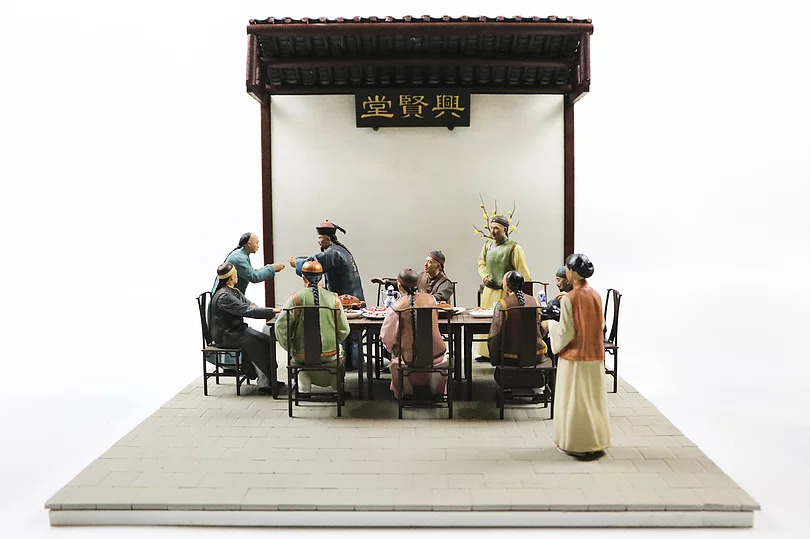
In the entire miniature scene, each figure is about 10 centimeters and finely sculptured, appearing lively and perfectly staged the scene. So how did Nan Yu with his team take the time machine to ancient China and reproduce the vivid miniature scene? Let’s unveil how the fine art piece comes into being.
The artistic process of the miniature scene
1. Concept Design
Based on ancient records, Nan Yu drafted the miniature scene including five parts, which was also the standard process of an academy appointing a principal at that time in China.

2. 3D Scanning
Team members put on the costumes and poses. Then used EinScan-Pro from SHINING 3D to collect 3D data.
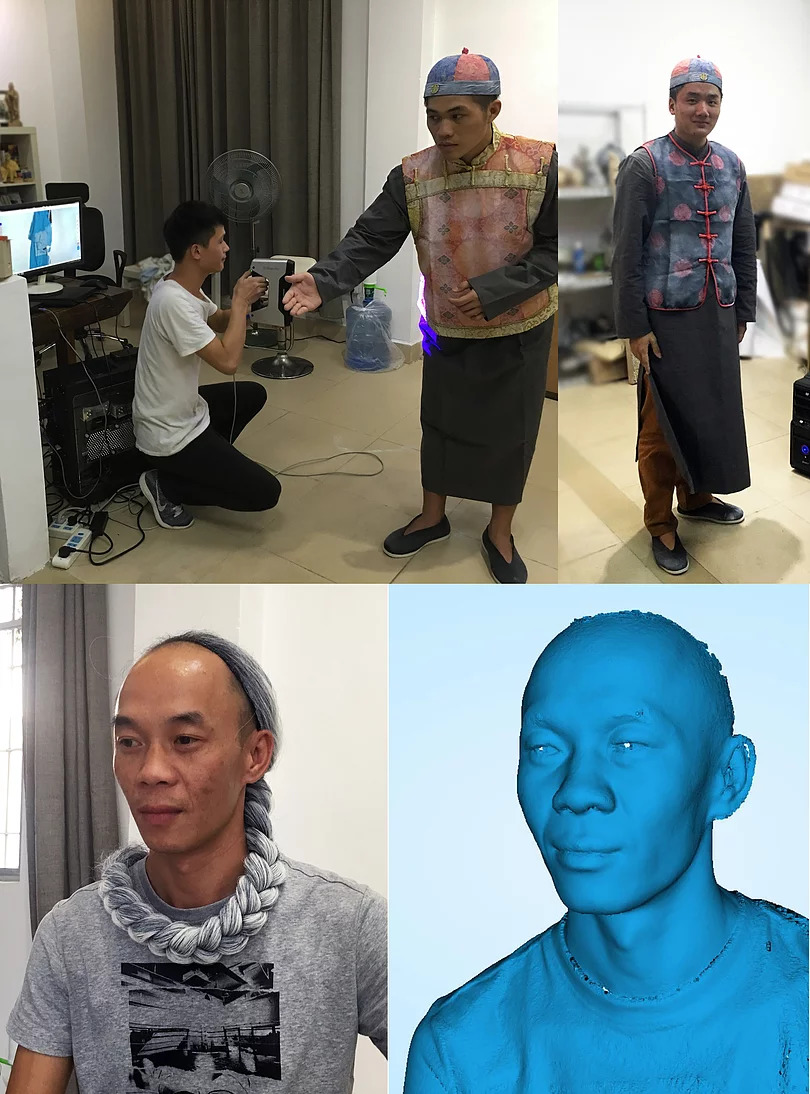
3. 3D Model Modify
Modified the collected 3D data and used data modeling to create the architectures in the scene. Combined the characters in the scene.
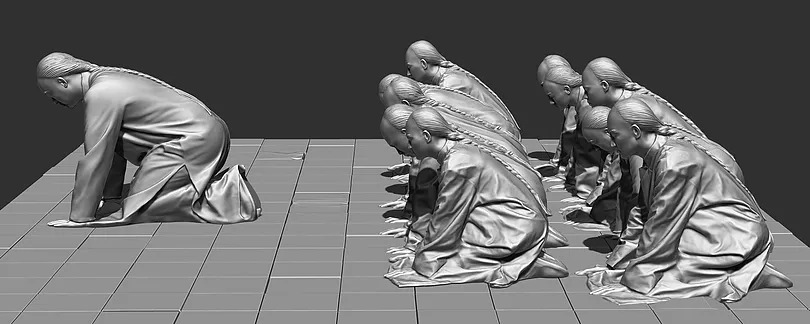
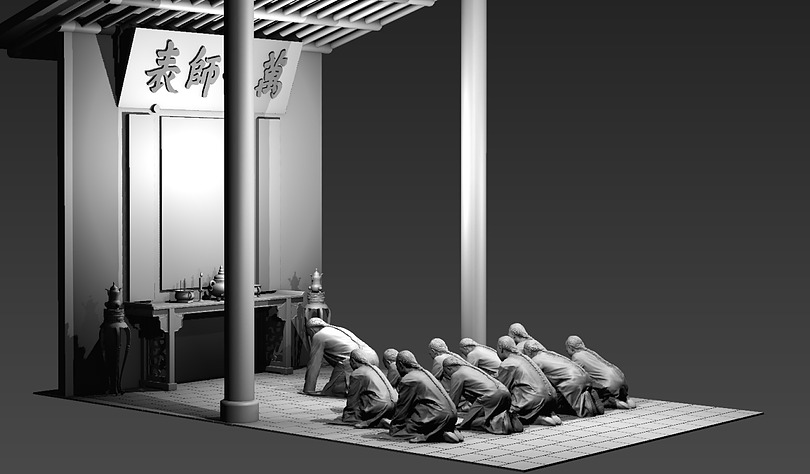
4. 3D printing and coloring
3D printed out the characters and architecture from the scene by SHINING 3D printer of SLA technology and then colored the art piece.
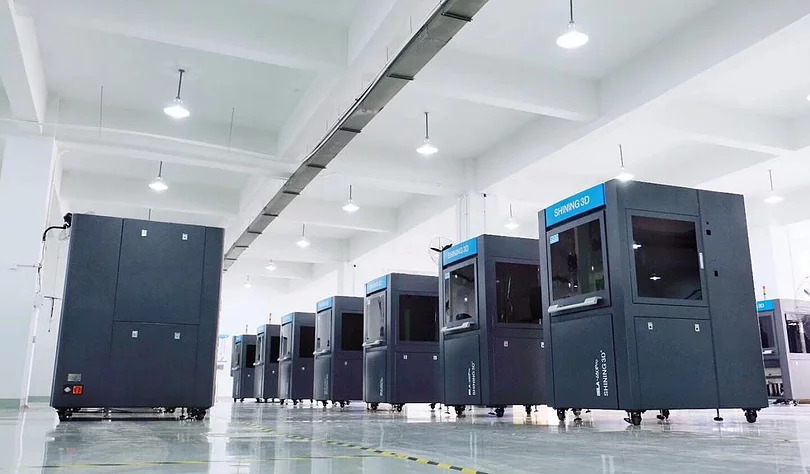
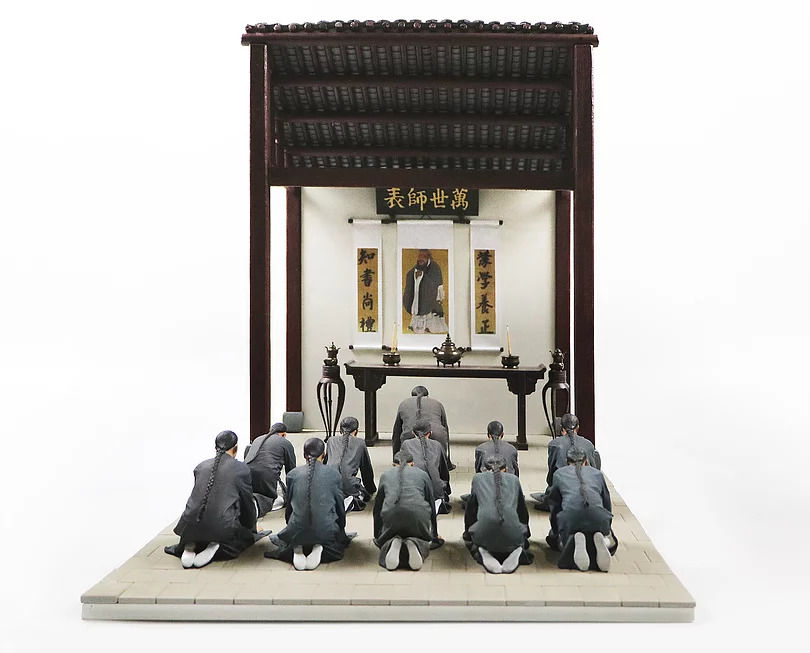
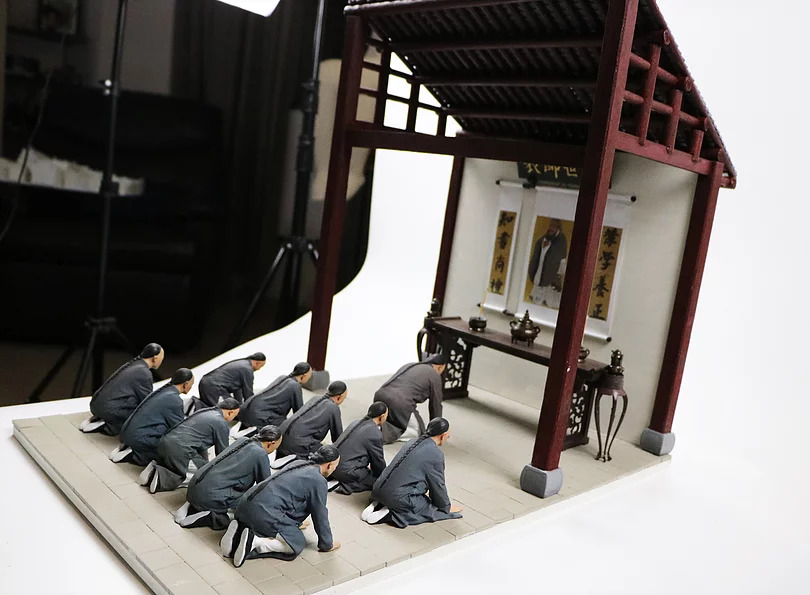
Let’s have a look at the 3D scenes and the final pieces
Scene 1: To prepare the appointment ceremony, chief of academy asked magistrate to issue the letter of appointment.
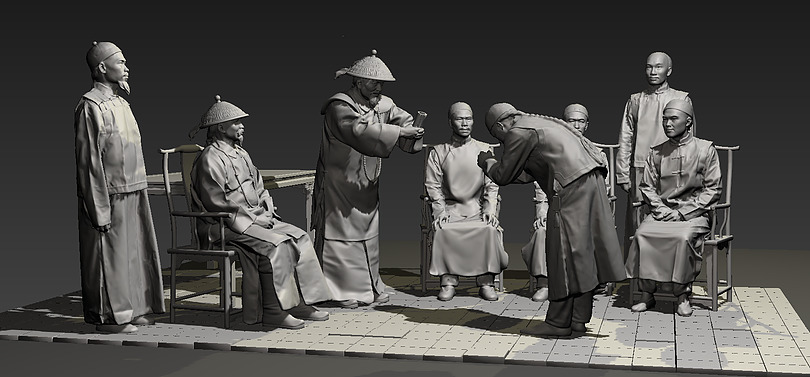
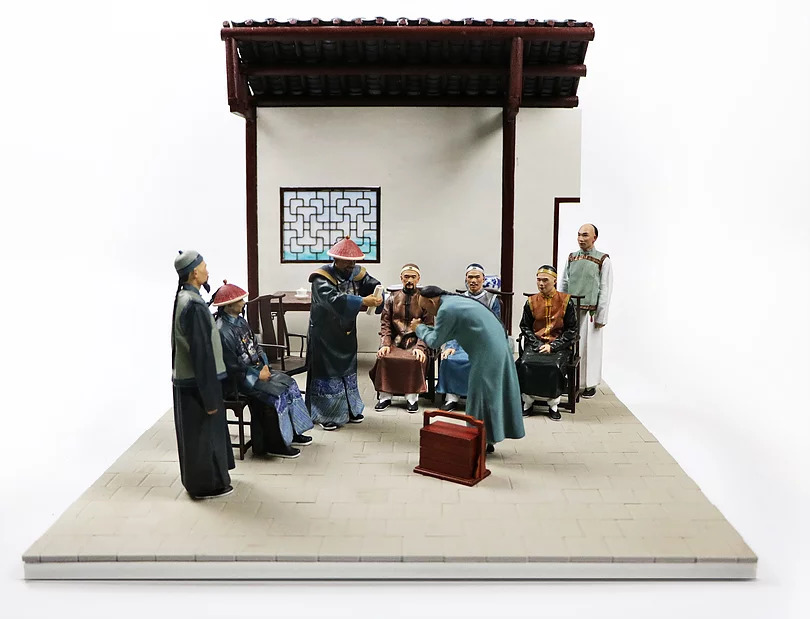
Scene 2: Principal arrived at the academy next spring and joined the banquet with the magistrate, instructor, disciplinarian and the chief.
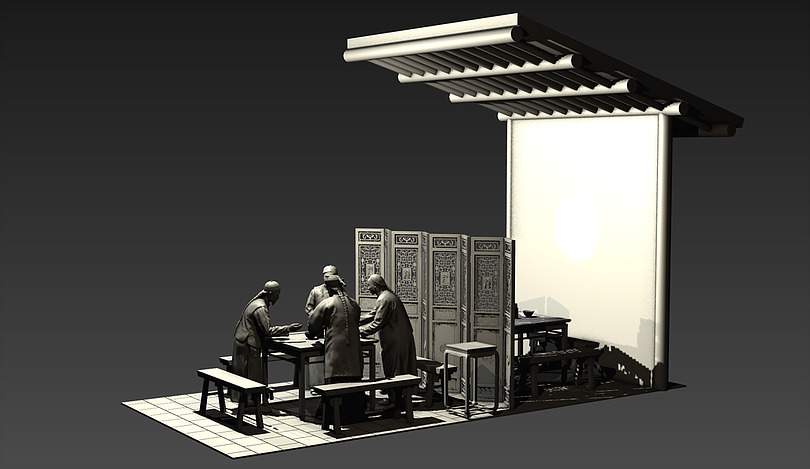
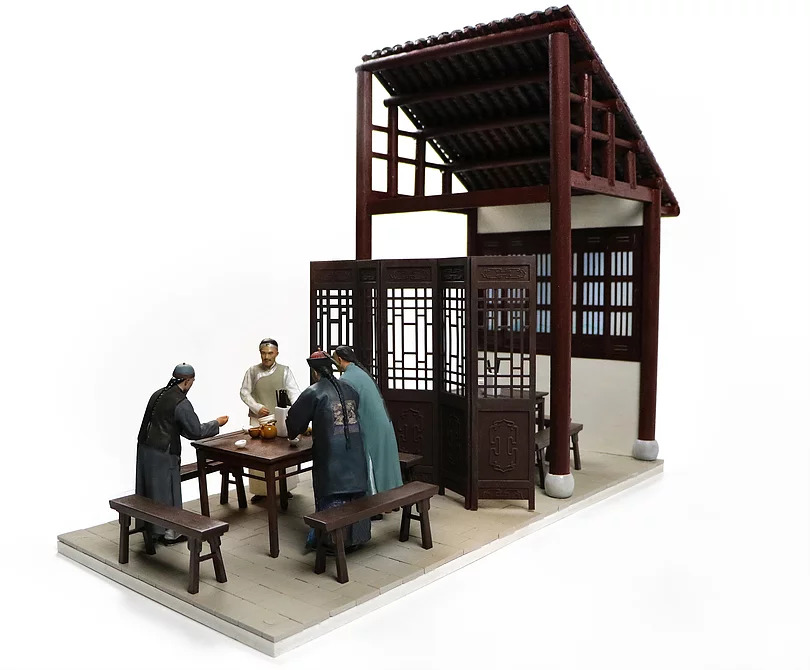
Scene 3: Chief of academy led students to salute to Confucius and principal.
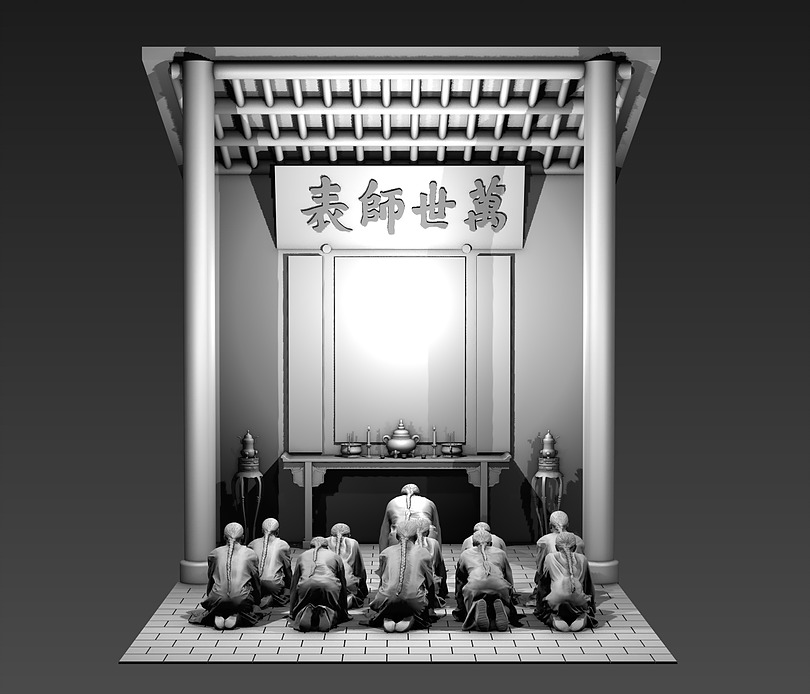
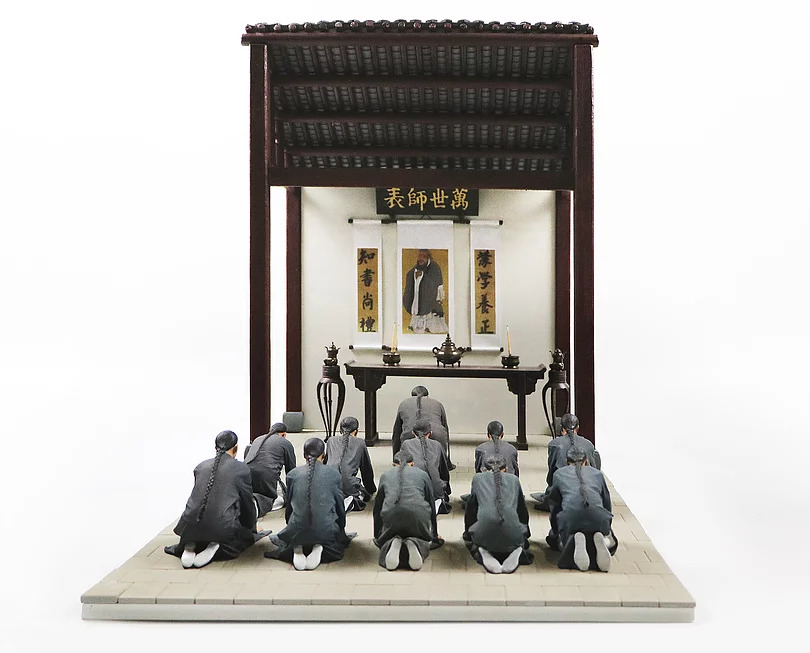
Scene 4: After the school started, chief of academy invited principal, magistrate and the two instructors for a drink.
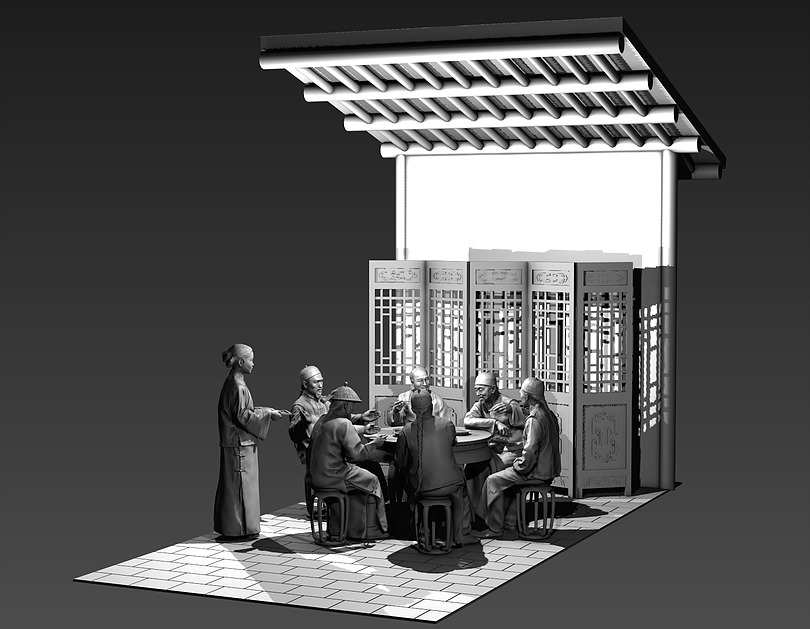

Scene 5: After a few days, the principal was invited to the Xingxian Hall for a banquet in a highly respectful manner.
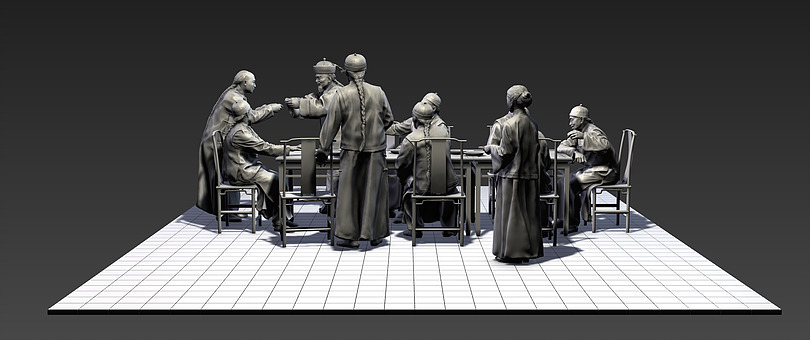
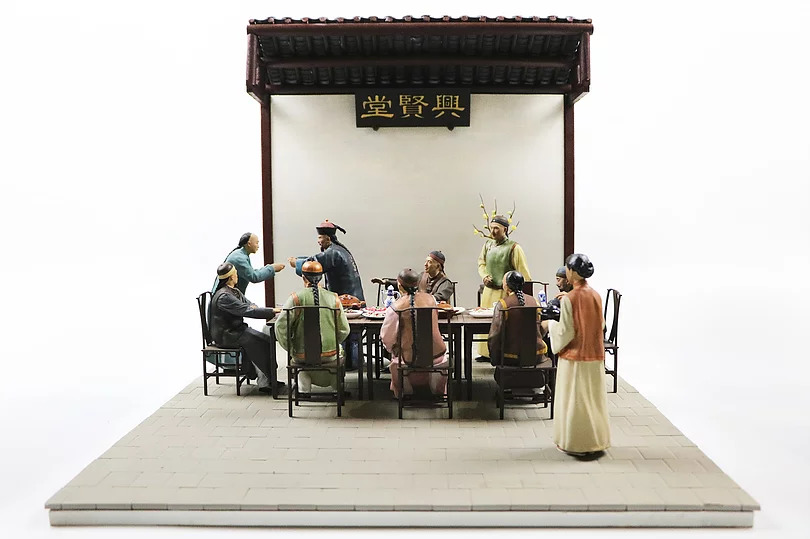
“The combination of art and 3D technology can make the abstract history representational, allowing more public to relive history, experience the traditional virtual of respecting teachers, and memorizing the historical people and events,” said Nan Yu. Thanks to the advanced handheld 3D scanning and 3D printing technology of SHINING 3D, history is now livelier.
Enjoy Professor Nan Yu’s artwork produced by 3D technologies

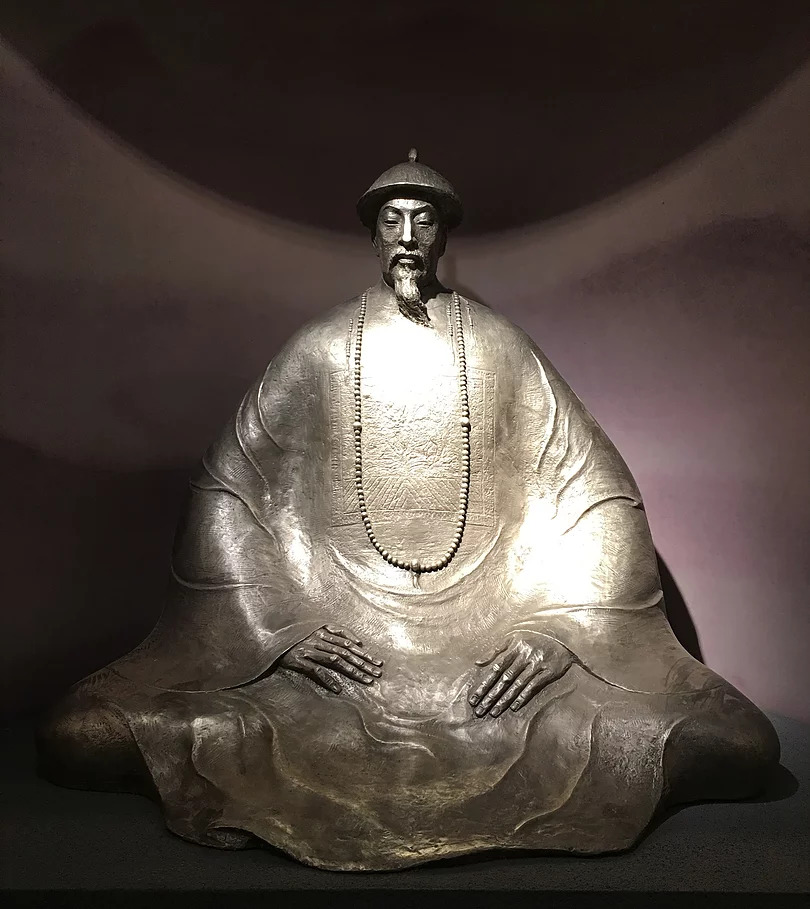
Tso Tsung-Tang Artist: Nan Yu
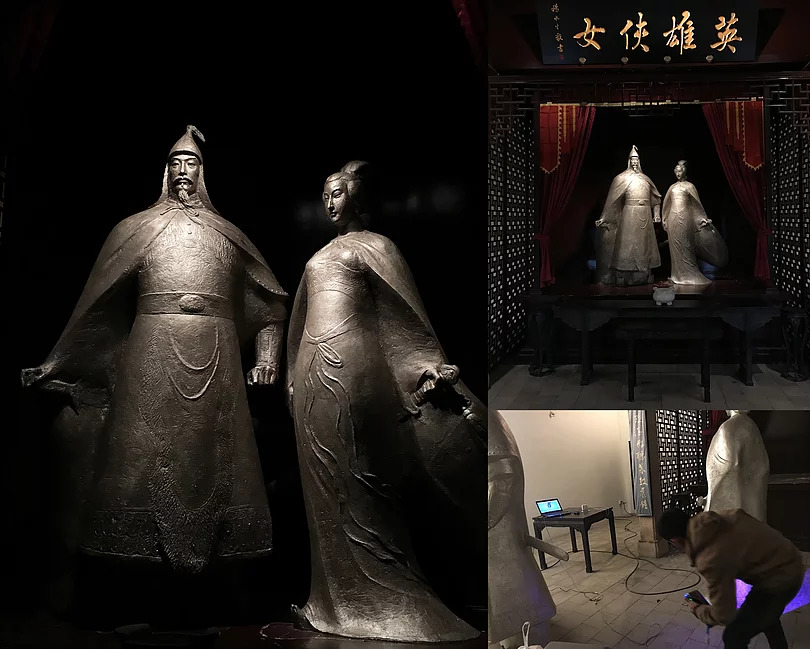
Hero and Heroine — Li Jing and Hong Fu Artist: Nan Yu
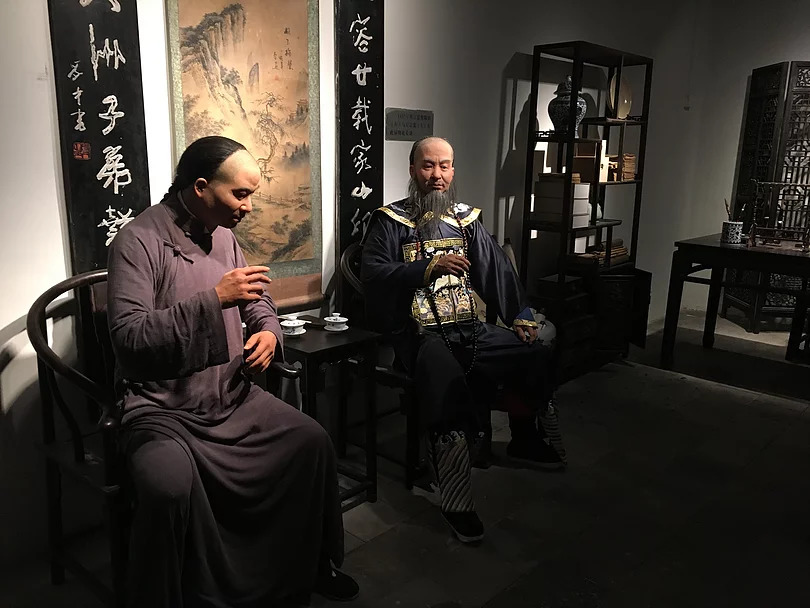
Tso Tsung-Tang talked Tao Shu all night Artist : Nan Yu
Background:
Imagine how exciting would someone living in Miami be when he wakes up to find a rainforest outside his door? Similarly, how surprised would a sunbather in Sanya be if an iceberg emerged in the water right in front of her? The “psychological impact” brought upon by such extreme variation is exactly what artists are looking for.
The Artwork Iceland
At the Art Sanya Festival, an artwork titled Iceland had impressed every visitor, circulating on everyone’s social media. This is because the work had allowed visitors to understand that with technology, distance is no longer an issue. Now, we can enjoy the view full of snow-white icebergs in Sanya, even actually icebergs located thousands of miles away…
The fabulous artwork was created by Jiayu Liu from the U.K. Royal College of Art. Liu had used Shining 3D’s multifunctional handheld 3D scanner EinScan-Pro during the course of creating the artwork. You can take a look at the video to see how this artwork; video link: https://v.qq.com/x/page/o0385425slw.html.
With the help of the EinScan-Pro 3D scanning technology, the artist was able to bring the magic of nature into the studio, and then turn it into a physical object through 3D digital technology.

Inspirations
The inspiration for this artwork came from a rather ordinary-looking hotel garden. If you were a guest at this hotel, you probably just walk by it without staying there deliberately. However, Liu was inspired for that moment: she wanted to make these nondescript rocks here shine, through installing strings of light inside these rocks to simulate the translucent look of icebergs.
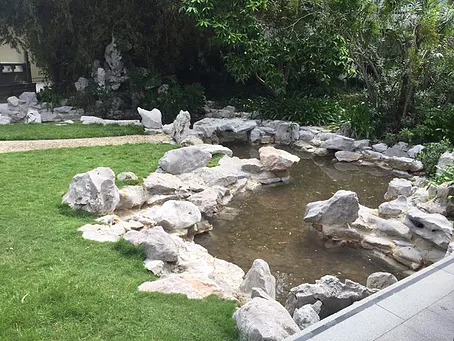
(The hotel garden inspired Liu)
Reproduction
Liu faced the issue that it was not practical to install lights inside these hard rocks. Using artificial rocks would spoil the original layout of the garden. How to create her work while not destroying the original scene became the biggest challenge for Liu.
Since Liu had prior experience with 3D scanning, she very quickly thought of obtaining the dimensions and forms of the rocks by means of 3D scanning. After trying out and comparing scanners from various companies in terms of performance and scanning results, Liu opted for the EinScan-Pro from Shining 3D.
Challenges in scanning
1. Large size of the rocks
2. Large amount of surface details
3. Partial blocking due to overlapping of rocks
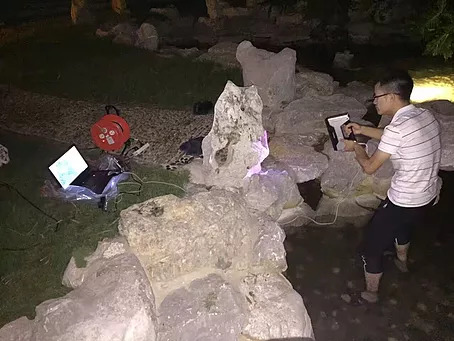
The scanning process
The high speed of the EinScan-Pro handheld scan mode and the high level of details obtained allowed the scanning process to go smoothly. The time spent on 3D scanning was shortened as much as possible while accuracy demands were being met. This gave the artist enough time for subsequent tasks.
Liu’s team first selected the handheld rapid scan mode to scan. You do not need to stick markers under this mode, making the process even more efficient as pre-scan prep work was minimized. Also, the scanning precision could be as high as 0.3mm under handheld rapid scan mode.
Subsequently, Liu’s team processed the scan data and created the models of the rocks using translucent PC boards. After then, they installed LED lights in accordance with the look of icebergs in terms of translucence and refraction. Finally, they set up the model onto the surface of the rocks in the garden.
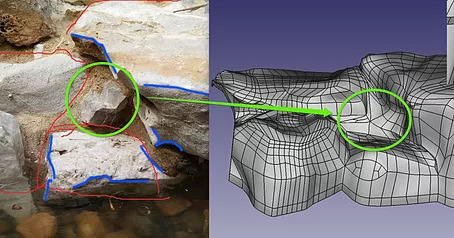
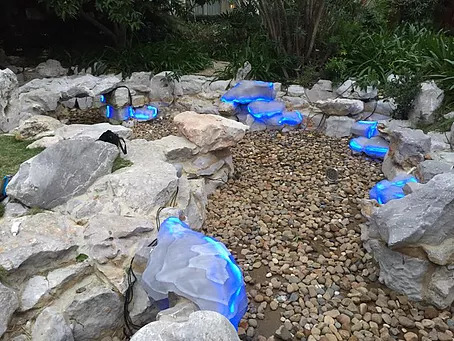
And then the last thing to do was to wait for the nightfall.
As the blue lights lit up, the ordinary hotel garden was transformed into a sea of icebergs that glowed and shone in the quite night.

Summary
With the help of EinScan-Pro, the artist obtained precise 3D scan data and thus had an accurate calculation on the surrounding environment, which also led to a subsequent stream of model-making and light installations completed successfully. The project is not only the perfect combination of technology and art but also brings together scenes from two extremely different geographical locations, creating limitless visual impact and a boundless sense of immersion in individuals.